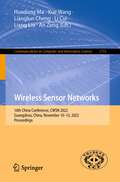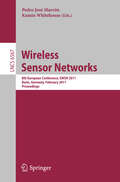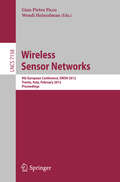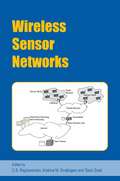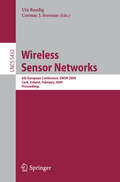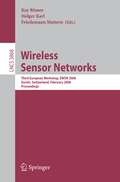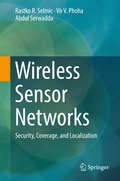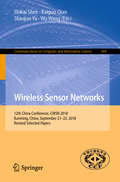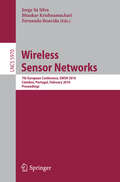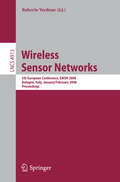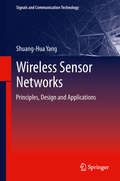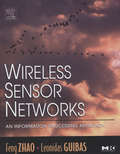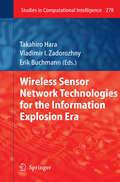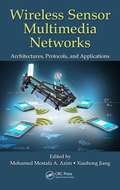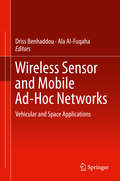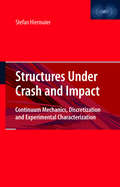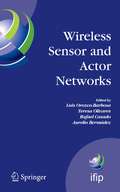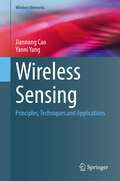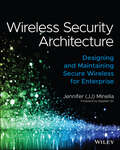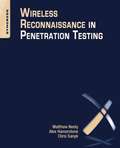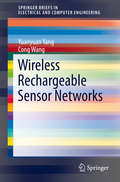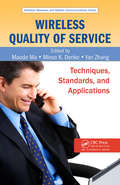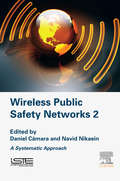- Table View
- List View
Wireless Sensor Networks: 16th China Conference, CWSN 2022, Guangzhou, China, November 10–13, 2022, Proceedings (Communications in Computer and Information Science #1715)
by Huadong Ma Xue Wang Lianglun Cheng Li Cui Liang Liu An ZengThis book constitutes the refereed proceedings of the 16th China Conference on Wireless Sensor Networks, CWSN 2022, which took place in Guangzhou, China, in November 2022. The 17 full papers presented in this volume were carefully reviewed and selected from 204 submissions, including 87 English papers and 117 Chinese papers. The conference provided an academic exchange of research and a development forum for IoT researchers, developers, enterprises, and users. Exchanging results and experience of research and applications in IoT, and discussing the key challenges and research hotspots, is the main goal of the forum. As a high-level forum for the design, implementation, and application of IoT, the conference promoted the exchange and application of the oriesand technologies of IoT-related topics.
Wireless Sensor Networks: 8th European Conference, EWSN 2011, Bonn, Germany, February 23-25, 2011, Proceedings (Lecture Notes in Computer Science #6567)
by Pedro José Marrón Kamin WhitehouseThis book constitutes the refereed proceedings of the 8th European Conference on Wireless Sensor Networks, EWSN 2011, held in Bonn, Germany, in February 2011. The 14 revised full papers presented were carefully reviewed and selected from 87 submissions. The papers are organized in topical sections on routing and mobility, optimization techniques, MAC protocols, algorithms, and systems and abstractions.
Wireless Sensor Networks: 9th European Conference, EWSN 2012, Trento, Italy, February 15-17, 2012, Proceedings (Lecture Notes in Computer Science #7158)
by Gian Pietro Picco Wendi HeinzelmanThis book constitutes the refereed proceedings of the 9th European Conference on Wireless Sensor Networks, EWSN 2012, held in Trento, Italy, in Februar 2012. The 16 revised full papers presented were carefully reviewed and selected from 78 submissions. The papers are organized in topical sections on communication and security, system issues, reliability, localization and smart cameras, and hardware and sensing.
Wireless Sensor Networks (Ercoftac Ser.)
by C. S. RaghavendraWireless Sensor Networks presents a comprehensive and tightly organized compilation of chapters that surveys many of the exciting research developments taking place in this field. Chapters are written by several of the leading researchers exclusively for this book. Authors address many of the key challenges faced in the design, analysis and deployment of wireless sensor networks.
Wireless Sensor Networks: 6th European Conference, EWSN 2009 Cork, Ireland, February 11-13, 2009, Proceedings (Lecture Notes in Computer Science #5432)
by Utz Rödig Cormac J. SreenanThis book constitutes the refereed proceedings of the 6th European Conference on Wireless Sensor Networks, EWSN 2009, held in Cork, Ireland, in Februar 2009. The 23 revised full papers presented were carefully reviewed and selected from 145 submissions. The papers are organized in topical sections on performance and quality of service, routing, coordination and synchronisation, data collection, security, as well as evaluation and management.
Wireless Sensor Networks: Third European Workshop, EWSN 2006, Zurich, Switzerland, February 13-15, 2006, Proceedings (Lecture Notes in Computer Science #3868)
by Kay Römer Holger Karl Friedemann MatternThis book constitutes the refereed proceedings of the Third European Workshop on Wireless Sensor Networks February 2006. The 21 revised full papers presented together with the abstracts of one invited talk and two tutorials were carefully reviewed and selected from 133 submissions. The papers are organized in topical sections on query systems, sensor network services, routing, localization, platforms and development, medium access control, and measurements.
Wireless Sensor Networks: Security, Coverage, and Localization (Advances In Information Security Ser. #Vol. 69)
by Rastko R. Selmic Vir V. Phoha Abdul SerwaddaThis book presents a comprehensive overview of wireless sensor networks (WSNs) with an emphasis on security, coverage, and localization. It offers a structural treatment of WSN building blocks including hardware and protocol architectures and also provides a systems-level view of how WSNs operate. These building blocks will allow readers to program specialized applications and conduct research in advanced topics.A brief introductory chapter covers common applications and communication protocols for WSNs. Next, the authors review basic mathematical models such as Voroni diagrams and Delaunay triangulations. Sensor principles, hardware structure, and medium access protocols are examined. Security challenges ranging from defense strategies to network robustness are explored, along with quality of service measures. Finally, this book discusses recent developments and future directions in WSN platforms.Each chapter concludes with classroom-tested exercises that reinforce key concepts. This book is suitable for researchers and for practitioners in industry. Advanced-level students in electrical engineering and computer science will also find the content helpful as a textbook or reference.
Wireless Sensor Networks: 12th China Conference, CWSN 2018, Kunming, China, September 21–23, 2018, Revised Selected Papers (Communications in Computer and Information Science #984)
by Shikai Shen Kaiguo Qian Shaojun Yu Wu WangThis book constitutes the refereed proceedings of the 12th China Conference on Wireless Sensor Networks, CWSN 2018, held in Kunming, China, in September 2018. The 16 revised full papers were carefully reviewed and selected from 177 submissions. The papers are organized in topical sections on algorithm for wireless sensor network; positioning and location; neural network; energy efficiency and harvesting; privacy and security; image processing.
Wireless Sensor Networks: 7th European Conference, EWSN 2010, Coimbra, Portugal, February 17-19, 2010, Proceedings (Lecture Notes in Computer Science #5970)
by Jorge Sá Silva Bhaskar Krishnamachari Fernando BoavidaIt is our great pleasure to present the proceedings of the European Conference on Wireless Sensor Networks 2010 (EWSN 2010). As the field of wireless sensor networks matures, new design concepts, experim- tal and theoretical findings, and applications have continued to emerge at a rapid pace. As one of the leading international conferences in this area, EWSN has played a s- stantial role in the dissemination of innovative research ideas from researchers all over the globe. EWSN 2010 was organized by the University of Coimbra, Portugal, during February 17–19, 2010 and it was the seventh meeting in this series. Previous events were held in Berlin (Germany) in 2004, Istanbul (Turkey) in 2005, Zurich (Switz- land) in 2006, Delft (The Netherlands) in 2007, and Cork (Ireland) in 2009. A high-quality selection of papers made up EWSN 2010. Based on the reviews and the recommendations from the four live TPC discussions, we selected a total of 21 papers from 109 submissions (19.26% acceptance rate) for EWSN 2010. Topics of interest included hardware design and implementation, operating systems and so- ware, middleware and macroprogramming, communication and network protocols, information and signal processing, fundamental theoretical limits and algorithms, prototypes, field experiments, testbeds, novel applications, including urban sensing, security and fault-tolerance. Putting together EWSN 2010 was a team effort. We would like to thank the P- gram Committee members, the reviewers, our sponsors, all authors, and the Organ- ing Committee for their respective contributions.
Wireless Sensor Networks: 5th European Conference, EWSN 2008, Bologna, Italy, January 30-February 1, 2008, Proceedings (Lecture Notes in Computer Science #4913)
by Roberto VerdoneWireless Sensor Networks: Principles, Design and Applications (Signals and Communication Technology)
by Shuang-Hua YangWireless Sensor Networks presents the latest practical solutions to the design issues presented in wireless-sensor-network-based systems. Novel features of the text, distributed throughout, include workable solutions, demonstration systems and case studies of the design and application of wireless sensor networks (WSNs) based on the first-hand research and development experience of the author, and the chapters on real applications: building fire safety protection; smart home automation; and logistics resource management. Case studies and applications illustrate the practical perspectives of:· sensor node design;· embedded software design;· routing algorithms;· sink node positioning;· co-existence with other wireless systems;· data fusion;· security;· indoor location tracking;· integrating with radio-frequency identification; and· Internet of thingsWireless Sensor Networks brings together multiple strands of research in the design of WSNs, mainly from software engineering, electronic engineering, and wireless communication perspectives, into an over-arching examination of the subject, benefiting students, field engineers, system developers and IT professionals. The contents have been well used as the teaching material of a course taught at postgraduate level in several universities making it suitable as an advanced text book and a reference book for final-year undergraduate and postgraduate students.
Wireless Sensor Networks: An Information Processing Approach (ISSN)
by Feng Zhao Leonidas GuibasInformation processing in sensor networks is a rapidly emerging area of computer science and electrical engineering research. Because of advances in micro-sensors, wireless networking and embedded processing, ad hoc networks of sensor are becoming increasingly available for commercial, military, and homeland security applications. Examples include monitoring (e.g., traffic, habitat, security), industrail sensing and diagnostics (e.g., factory, appliances), infrastructures (i.e., power grid, water distribution, waste disposal) and battle awareness (e.g., multi-target tracking). This book introduces practitioners to the fundamental issues and technology constraints concerning various aspects of sensor networks such as information organization, querying, routing, and self-organization using concrete examples and does so by using concrete examples from current research and implementation efforts.Written for practitioners, researchers, and students and relevant to all application areas, including environmental monitoring, industrial sensing and diagnostics, automotive and transportation, security and surveillance, military and battlefield uses, and large-scale infrastructural maintenanceSkillfully integrates the many disciplines at work in wireless sensor network design: signal processing and estimation, communication theory and protocols, distributed algorithms and databases, probabilistic reasoning, energy-aware computing, design methodologies, evaluation metrics, and moreDemonstrates how querying, data routing, and network self-organization can support high-level information-processing tasks
Wireless Sensor Network Technologies for the Information Explosion Era (Studies in Computational Intelligence #278)
by Takahiro Hara Vladimir I. Zadorozhny Erik BuchmannWireless Sensor Network Technologies for Information Explosion Era The amount and value of information available due to rapid spread of information technology is exploding. Typically, large enterprises have approximately a petabyte of operational data stored in hundreds of data repositories supporting thousands of applications. Data storage volumes grow in excess of 50% annually. This growth is expected to continue due to vast proliferation of existing infor- tion systems and the introduction of new data sources. Wireless Sensor Networks (WSNs) represent one of the most notable examples of such new data sources. In recent few years, various types of WSNs have been deployed and the amount of information generated by wireless sensors increases rapidly. The information - plosion requires establishing novel data processing and communication techniques for WSNs. This volume aims to cover both theoretical and practical aspects - lated to this challenge, and it explores directions for future research to enable ef- cient utilization of WSNs in the information-explosion era. The book is organized in three main parts that consider (1) technical issues of WSNs, (2) the integration of multiple WSNs, and (3) the development of WSNs systems and testbeds for conducting practical experiments. Each part consists of three chapters.
Wireless Sensor Multimedia Networks: Architectures, Protocols, and Applications
by Mohamed Mostafa A. Azim Xiaohong JiangWireless sensor networks (WSNs) are a special class of ad hoc network in which network nodes composed of tiny sensors pass data such as temperature, pressure, and humidity through the network to a central location. Wireless sensor multimedia networks (WSMNs) are a special category of WSNs in which the sensor nodes are small cameras and microphones
Wireless Sensor Multimedia Networks: Architectures, Protocols, and Applications
by Mohamed Mostafa A. Azim Xiaohong JiangWireless sensor networks (WSNs) are a special class of ad hoc network in which network nodes composed of tiny sensors pass data such as temperature, pressure, and humidity through the network to a central location. Wireless sensor multimedia networks (WSMNs) are a special category of WSNs in which the sensor nodes are small cameras and microphones
Wireless Sensor and Mobile Ad-Hoc Networks: Vehicular and Space Applications
by Driss Benhaddou Ala Al-FuqahaWireless sensor Networks: Vehicle and Space Applications describes the practical perspectives in using wireless sensor networks (WSN) to develop real world applications that can be used for space exploration. These applications include sensor interfaces, remote wireless vehicles, space crew health monitoring and instrumentation. The material discusses how applications of WSN originally developed for space travel and exploration are being applied and used in multiple real world applications, allowing for the development of smart systems that have characteristics such as self healing, self diagnosis, and emergency healthcare notification.
Wireless Sensor and Actor Networks II: Proceedings of the 2008 IFIP Conference on Wireless Sensor and Actor Networks (WSAN 08), Ottawa, Ontario, Canada, July 14-15, 2008 (IFIP Advances in Information and Communication Technology #264)
by Ali MiriThis book constitutes the refereed proceedings of the IFIP Conference on Wireless Sensors and Actor Networks held in Ottawa, Canada, July, 2008. This series publishes state-of-the-art results in the sciences and technologies of information and communication. The scope of the series includes: foundations of computer science; software theory and practice; education; computer applications in technology; communication systems; systems modeling and optimization; information systems; computers and society; computer systems technology; security and protection in information processing systems; artificial intelligence; and human-computer interaction. Proceedings and post-proceedings of refereed international conferences in computer science and interdisciplinary fields are featured. These results often precede journal publication and represent the most current research. The principal aim of the IFIP series is to encourage education and the dissemination and exchange of information about all aspects of computing.
Wireless Sensor and Actor Networks: IFIP WG 6.8 First International Conference on Wireless Sensor and Actor Networks, WSAN'07, Albacete, Spain, September 24-26, 2007 (IFIP Advances in Information and Communication Technology #248)
by Luis Orozco-Barbosa Teresa Olivares Rafael Casado Aurelio BermúdezThis book presents the proceedings of the first IFIP WG 6.8 conference on Wireless Sensor and Actor Networks held in Albacete, Spain. The papers selected to be included in this volume illustrate the state-of-the-art and current trends in the area of wireless sensor and actor networks. The comprehensive program was organized into eight topics: Actors; Applications; Security; Energy; Quality of Service; Localization; Middleware; Protocols.
Wireless Sensing: Principles, Techniques and Applications (Wireless Networks)
by Jiannong Cao Yanni YangThis book systematically presents the wireless sensing technology, which has become a promising sensing paradigm in recent years. It includes the introduction of underlying sensing principles, wireless signals, sensing methodologies and enabled applications. Meanwhile, it provides case studies to demonstrate how wireless sensing is applied for representative human and object sensing applications.This book also provides a wireless sensing framework as a guidance to understand and design a wireless sensing system or prototype based on their needs. It also presents a critical investigation of the challenges in achieving wireless sensing in both signal-level and application-level contexts. Accordingly, it summarizes the typical solutions to tackle the related challenges.Researchers and advanced-level students in computer science or electrical engineering working on the design of a wireless system will find this book useful as a reference. Professionals working in the wireless sensing industry will also find this book valuable as a reference tool.
Wireless Security Architecture: Designing and Maintaining Secure Wireless for Enterprise
by Jennifer MinellaReduce organizational cybersecurity risk and build comprehensive WiFi, private cellular, and IOT security solutions Wireless Security Architecture: Designing and Maintaining Secure Wireless for Enterprise offers readers an essential guide to planning, designing, and preserving secure wireless infrastructures. It is a blueprint to a resilient and compliant architecture that responds to regulatory requirements, reduces organizational risk, and conforms to industry best practices. This book emphasizes WiFi security, as well as guidance on private cellular and Internet of Things security. Readers will discover how to move beyond isolated technical certifications and vendor training and put together a coherent network that responds to contemporary security risks. It offers up-to-date coverage—including data published for the first time—of new WPA3 security, Wi-Fi 6E, zero-trust frameworks, and other emerging trends. It also includes: Concrete strategies suitable for organizations of all sizes, from large government agencies to small public and private companies Effective technical resources and real-world sample architectures Explorations of the relationships between security, wireless, and network elements Practical planning templates, guides, and real-world case studies demonstrating application of the included conceptsPerfect for network, wireless, and enterprise security architects, Wireless Security Architecture belongs in the libraries of technical leaders in firms of all sizes and in any industry seeking to build a secure wireless network.
Wireless Security Architecture: Designing and Maintaining Secure Wireless for Enterprise
by Jennifer MinellaReduce organizational cybersecurity risk and build comprehensive WiFi, private cellular, and IOT security solutions Wireless Security Architecture: Designing and Maintaining Secure Wireless for Enterprise offers readers an essential guide to planning, designing, and preserving secure wireless infrastructures. It is a blueprint to a resilient and compliant architecture that responds to regulatory requirements, reduces organizational risk, and conforms to industry best practices. This book emphasizes WiFi security, as well as guidance on private cellular and Internet of Things security. Readers will discover how to move beyond isolated technical certifications and vendor training and put together a coherent network that responds to contemporary security risks. It offers up-to-date coverage—including data published for the first time—of new WPA3 security, Wi-Fi 6E, zero-trust frameworks, and other emerging trends. It also includes: Concrete strategies suitable for organizations of all sizes, from large government agencies to small public and private companies Effective technical resources and real-world sample architectures Explorations of the relationships between security, wireless, and network elements Practical planning templates, guides, and real-world case studies demonstrating application of the included conceptsPerfect for network, wireless, and enterprise security architects, Wireless Security Architecture belongs in the libraries of technical leaders in firms of all sizes and in any industry seeking to build a secure wireless network.
Wireless Reconnaissance in Penetration Testing
by Matthew Neely Alex Hamerstone Chris SanykIn many penetration tests, there is a lot of useful information to be gathered from the radios used by organizations. These radios can include two-way radios used by guards, wireless headsets, cordless phones and wireless cameras. Wireless Reconnaissance in Penetration Testing describes the many ways that a penetration tester can gather and apply the information available from radio traffic. Stopping attacks means thinking like an attacker, and understanding all the ways that attackers gather information, or in industry terms profile, specific targets. With information from what equipment to use and how to find frequency information, to tips for reducing radio information leakage, to actual case studies describing how this information can be used to attack computer systems, this book is the go-to resource for penetration testing and radio profiling. Author Matthew Neely is a respected and well-known expert and speaker on radio reconnaissance and penetration testingIncludes real-world case studies of actual penetration tests using radio profilingCovers data leakage, frequency, attacks, and information gathering
Wireless Rechargeable Sensor Networks (SpringerBriefs in Electrical and Computer Engineering)
by Yuanyuan Yang Cong WangThis SpringerBrief provides a concise guide to applying wireless energy transfer techniques in traditional battery-powered sensor networks. It examines the benefits and challenges of wireless power including efficiency and reliability. The authors build a wireless rechargeable sensor networks from scratch and aim to provide perpetual network operation. Chapters cover a wide range of topics from the collection of energy information and recharge scheduling to joint design with typical sensing applications such as data gathering. Problems are approached using a natural combination of probability theory, optimization, algorithm and protocol designs. All proposed mechanisms are evaluated by extensive simulations. Wireless Rechargeable Sensor Networks targets professionals and researchers working in networks, wireless communications, energy technology and information technology. Advanced-level students studying electrical engineering and computer science will also find this material useful as a study guide.
Wireless Quality of Service: Techniques, Standards, and Applications
by Maode Ma Mieso K. DenkoFocusing on an important and complicated topic in wireless network design, Wireless Quality of Service: Techniques, Standards, and Applications systematically addresses the quality-of-service (QoS) issues found in many types of popular wireless networks. In each chapter, the book presents numerous QoS challenges encountered in real-world
Wireless Public Safety Networks 2: A Systematic Approach
by Daniel Câmara Navid NikaeinWireless Public Safety Networks, Volume Two: A Systematic Approach presents the latest advances in the wireless Public Safety Networks (PSNs) field, the networks established by authorities to either prepare the population for an eminent catastrophe, or those used for support during crisis and normalization phases. Maintaining communication capabilities in a disaster scenario is crucial for avoiding loss of lives and damages to property. This book examines past communication failures that have directly contributed to the loss of lives, giving readers in-depth discussions of the public networks that impact emergency management, covering social media, crowdsourcing techniques, wearable wireless sensors, moving-cells scenarios, mobility management protocols, 5G networks, broadband networks, data dissemination, and the resources of the frequency spectrum. Provides a focus on specific enabling technologies which can help the most on the deployment and usage of PSNs in real world scenariosProposes a general framework that has the capability to fulfill the public safety requirements and dynamically adapt to different public safety situationsInvestigates the problem of data dissemination over PSNs, presenting a review of the state-of-the-art of different information and communication technologies
